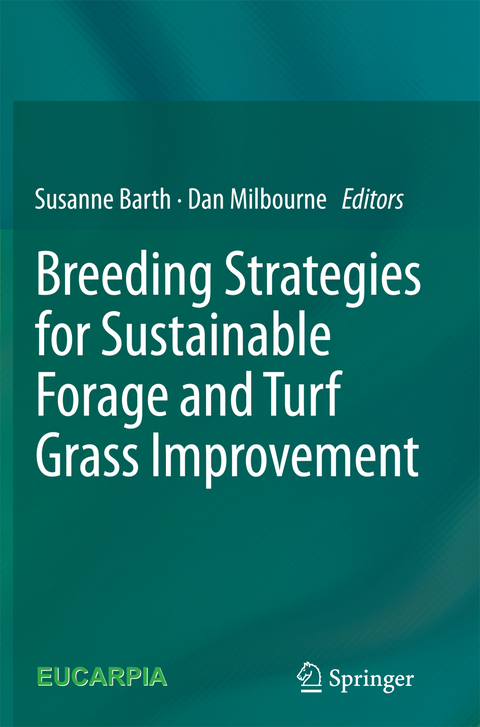
Breeding strategies for sustainable forage and turf grass improvement
Springer (Verlag)
978-94-017-8210-4 (ISBN)
Preface.- 1. What global and/or European agriculture will need from grasslands and grassland breeding over the next 10-15 years for a sustainable agriculture.- 2.1. Marker Assisted Selection Made Cheap and Easy.- 2.2. Genome-wide SNP marker development and QTL identification for genomic selection in red clover.- 2.3. Breeding for resistance to bacterial wilt in ryegrass: insights into the genetic control of plant resistance and pathogen virulence.- 2.4. Mechanisms utilized within the IBERS diploid Lolium perenne L. forage grass breeding programmes to improve rumen nitrogen use efficiency.- 2.5. Population genetics of the grass self-incompatibility system – Practical implications for grass breeding programmes.- 2.6. Use of molecular marker information in the construction of polycrosses to enhance yield in a Lolium perenne breeding programme.- 2.7. An analysis of chromosome pairing behaviour in newly synthesized alfalfa tetraploids by means of SSR markers.- 2.8. Genome constitution in selected and unselected plants of F2-F4 generations derived from an allotetraploid Festuca pratensis x Lolium perenne hybrid.- 2.9. Estimation of temporal allele frequency changes in ryegrass populations selected for axillary tiller development.- 2.10. Understanding the genetic basis for slow plant-mediated proteolysis in Festulolium hybrids.- 2.11. Chromosomal rearrangements in tetraploid introgressions of Lolium perenne/Festuca pratensis.- 3.1. Establishing Chromosome Genomics in Forage and Turf Grasses.- 3.2. DArTFest DNA Array – Applications and Perspectives for Grass Genetics, Genomic s and Breeding.- 3.3. Using DArT markers in Festuca x Lolium breeding.- 3.4. Development of an SNP identification pipeline for highly heterozygous crops.- 3.5. First insights into the mitochondrial genome of perennial ryegrass (Lolium perenne).- 3.6. Quantifying early vigour and ground cover using digital image analysis.- 3.7. Expression of the Lolium perenne TERMINAL FLOWER 1 gene in alfalfa and tobacco.- 3.8. Morphological and molecular characterization of branching in red clover (Trifolium pratense).- 4.1. Designing grass cultivars for droughts and floods.- 4.2. Variation and heritability of α-linolenic acid content and rumen escape protein fraction in fodder grass and clover.- 4.3. Similarities and differences in leaf proteome response to cold acclimation between Festuca pratensis and Lolium perenne.- 4.4. Multi-population QTL detection for flowering time, stem elongation and quality traits in Medicago truncatula.- 4.5. Role of RCT1 gene in anthracnose resistance in alfalfa.- 4.6. The EUCARPIA multi-site rust evaluation – results 2010.- 4.7. The main topics of resistance breeding in grasses in the Czeck Republic.- 5.1. Origins of diploid Dactylis from the Canary Islands as determined by DNA sequencing.- 5.2. Introduction and adaptation of Cynodon L. C. Richspecies in Australia.- 5.3. Variation in traits associated with carbon sequestration for a range of common amenity grass species.- 5.4. Suitability of different grass species for phytoremediation of soils polluted with heavy metals.- 5.5. Targeting Lucerne cultivars to saline-soil environments.- 5.6. Comparison of seed mixtures for technical revegetation at high altitude.- 5.7. Genetic diversity for cell wall digestibility in a diverse Lolium perenne collection.- 5.8. Variability among accessions of forage vetch for basic agronomic and morphological traits under agro-ecological conditions of Serbia.- 5.9. Genetic variation of root characteristics and deep root production in perennial ryegrass cultivars contrasting in field persistency.- 5.10. The study of similarities among Medicago sativa L. accessions.- 5.11. Genetic structure and agronomic value of Italian lucerne landacres: a synopsis. 5.12. The use of genebank accessions in the breeding programme of Lolium perenne.- 5.13. Characterization and evaluation of genebank accessions as a pre-selection instrument for plant breeding objectives and strategies.- 5.14. Exploitation of ‘site-specific’ Alpine grass germplasm for revegetation at high altitude.- 6.1. The impact of perennial ryegrass variety throughout the growing season on in vitro rumen methane output.- 6.2. Origin and yield of European perennial ryegrass (Lolium perenne L.) varieties in Ireland.- 6.3. Yield dynamics and quality of white clover and perennial ryegrass.- 6.4. Influence of plant growth promoting rhizobacteria on alfalfa, Medicago sativa L. yield by inoculation of a preceding Italian ryegrass, Lolium multiflorum Lam..- 6.5. Optimal plant type of pea for mixed cropping with cereals.- 6.6. Dry matter recovery and aerobic stability of maize whole-crop, cob and stover silages – harvest date and cultivar effects.- 6.7. Performance of forage soya bean (Glycine max) cultivars in the northern Balkans.- 6.8. Effects of trinexapac-ethyl (Moddus) on seed yields and its quality of eleven temperate grass species.- 6.9. The chemical composition of a range of forage grasses grown under two nitrogen fertilizer inputs and harvested at different stages of maturity.- 6.10. NIRS calibration strategies for the botanical composition of grass-clover mixtures.- 6.11. Comparison of LOCAL and GLOBAL calibration models to predict ryegrass quality using near infrared reflectance spectroscopy.- 6.12. Grass for biogas production – anaerobic methane production from give common grassland species at sequential stages of maturity.- Index.
| Erscheint lt. Verlag | 9.8.2014 |
|---|---|
| Zusatzinfo | XII, 392 p. |
| Verlagsort | Dordrecht |
| Sprache | englisch |
| Maße | 155 x 235 mm |
| Themenwelt | Naturwissenschaften ► Biologie ► Botanik |
| Naturwissenschaften ► Biologie ► Ökologie / Naturschutz | |
| Weitere Fachgebiete ► Land- / Forstwirtschaft / Fischerei | |
| Schlagworte | Forage and Turf • Genetics and Genomics • Grasses • Legumes • Plant Breeding |
| ISBN-10 | 94-017-8210-5 / 9401782105 |
| ISBN-13 | 978-94-017-8210-4 / 9789401782104 |
| Zustand | Neuware |
| Haben Sie eine Frage zum Produkt? |
aus dem Bereich


